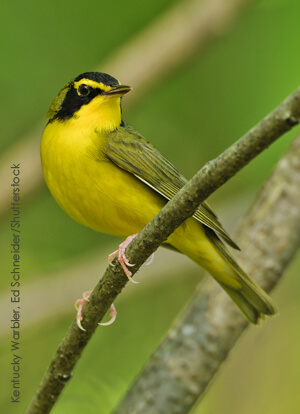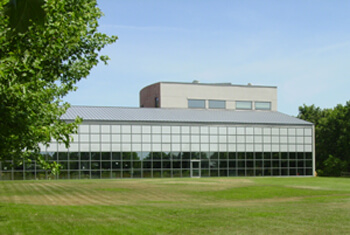New Jersey College Goes Bird Friendly: Cuts Electricity Costs, Reduces Fatal Bird Collisions
 |
(Washington, D.C., July 29, 2014) Atlantic Cape Community College, Cape May County Campus, has implemented a simple, innovative, and increasingly popular solution to two problems that affect thousands of buildings in the United States: escalating cooling costs and fatal bird collisions. The solution is a bird-friendly film installed over highly reflective and heat-conducting glass.
The dual problems of bird strikes and high utility costs associated with cooling the first floor began immediately after the college's Cape May County Campus—housed in a new, three-story, 68,000-foot building —was established in 2005.
“Bird collisions were occurring pretty much daily, and it was disturbing to students and faculty. While researching solutions, we realized we could also address the escalating energy costs at the same time,” said Lisa Apel-Gendron, senior campus administrator.
As the college began exploring approaches that would decrease the number of bird strikes and improve energy efficiency, they were advised to contact one of the leading U.S. authorities on bird collisions, Dr. Christine Sheppard of American Bird Conservancy (ABC). Sheppard has conducted extensive research on the phenomenon of bird collisions and has consulted with many communities to develop and implement bird-friendly guidelines for building construction.
“The experience at the Cape May County Campus is not unusual. Up to one billion birds are killed by building collisions each year, making it one of the top threats birds face in the United States. Bird collision mortality is certainly a contributing factor to the unfortunate reality that we now have over 200 species of birds in serious trouble,” said Sheppard, who oversees the Bird Collisions Program at ABC.
According to Sheppard, bird mortality from collisions with glass is a problem virtually anywhere there are birds and glass. In the most comprehensive study of its kind, involving the review and analysis of almost two dozen studies and over 92,000 records, federal scientists recently found that between 365 and 988 million birds are likely killed in the United States each year as a result of collisions with buildings. The study confirmed the conclusion that building collisions are second only to feral and free-ranging pet cats (estimated to kill as many as 3 billion birds each year) as the largest source of direct human-caused mortality for U.S. birds.
“Glass and window film manufacturers are responding to situations like the one we saw at Atlantic Cape,” said Sheppard, “and increasingly, legislation is being passed at municipal and state levels requiring bird-friendly design for new buildings and retrofit of existing facilities. This increasing call for more bird-friendly windows and doors has led to development of new products and repurposing of old ones.”
“At ABC, we evaluate and test these products and provide scientifically sound feedback that rates the degree of bird avoidance each new glass product delivers,” she continued.
Ultimately, Atlantic Cape decided to apply a window film called CollidEscape, one of the earliest solutions for bird collisions with glass. To birds, this product appears to be opaque, but people inside have a clear view of the outdoors. The college began installing the treatment on 255 windows in June, starting with the most problematic. They expect to finish the installation this month and will spend about $16,700 to purchase and install CollidEscape on the windows.
 |
Photo showing first phase of installation of Collidescape film on windows at the Cape May County Campus of Atlantic Cape Community College. Photo: Atlantic Cape Community College. |
The CollidEscape treatment has a track record of reducing bird strikes. Previously, the windows reflected the nearby trees and sky, making it appear to be a very real and inviting flyway for birds. With CollidEscape applied to the windows, there is essentially no reflection of the surrounding environs. Further, CollidEscape blocks about half the heat energy from the sun, suppressing both infrared and ultraviolet radiation. It also reduces glare, producing a more comfortable environment for students and staff and resulting in energy savings by reducing the air conditioning requirements.
“We have not seen any bird strikes since the installation was completed on the back wall, and we've also seen a significant improvement in comfort, glare reduction, and solar heat in the first floor lobby,” Apel-Gendron said.
Sheppard said that larger-scale concerns have led local and state governments to implement bird-friendly building codes or guidelines. For example, San Francisco, Oakland, Minnesota, and Toronto have already implemented bird-friendly building codes.
Sheppard and ABC have created a testing program to expand knowledge of the visual signals that deter bird collisions with glass and to provide support and feedback for companies developing new bird-friendly products. The ability to provide quantitative ratings for materials has proved essential in development of ordinances and guidelines for bird-friendly design. Efforts are underway to expand the capacity of the program as more companies identify bird-friendly construction and plan to retrofit existing buildings.
ABC's glass testing program is based at the Carnegie Museum's Powdermill Avian Research Center in Pennsylvania. Work is now underway on a second testing facility, jointly sponsored by ABC, New York City Audubon, New Jersey Audubon, and Ennead Architects. The goal is to expand capacity and to position the test as a standard for glass, alongside other characteristics like breaking strength and insulation.
Sheppard presents continuing education classes on the issue to architecture firms across the country upon request and authored the only national publication on the issue: American Bird Conservancy's Bird-Friendly Building Design.


















































